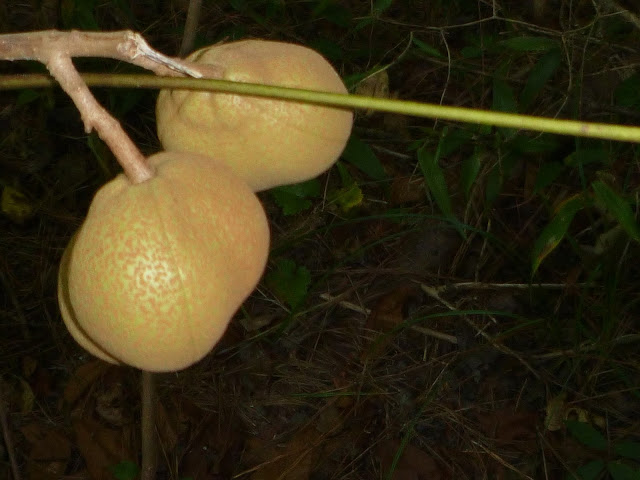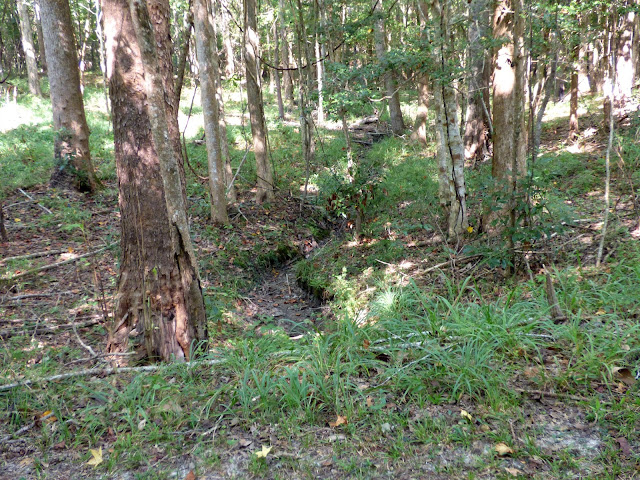Yesterday we took a trip down to Onslow County, NC to a fledgling 250 acre preserve at Everett Creek. It is one of the emerging jewels of the North Carolina Coastal Land Trust's efforts to conserve ecologically important habitats along the coastal plains of our beautiful state.
We are connect to this piece of Earth through a donation that my siblings and I made in 2011 of the memorable patch of woods from our youth, our grandfather's 15 acres of mixed hard woods and Loblolly pines in Lenoir County. The wooded property had become isolated by surrounding agricultural lands. Local agencies told us the property was not large enough for a park or nature preserve. So we were grateful that the NC Coastal Land Trust agreed to receive the donation as "trade-lands". The proceeds from the sale have been used to help support the Trust's programs including the Everett Creek Preserve. Our family was offered the opportunity to have a trail developed and named in memory of our grandfather. My wife and I walked a one mile section of that trail yesterday.
Over the past several years, NCCLT staff has worked to restore some of these acres to Longleaf Pine forest as well as returning native grasses to another significant portion of the preserve. This has required the use of periodic "controlled burns" to remove undergrowth and some of the under-story which can inhibit the development of a healthy stand of Longleaf Pine woods. Eventually these efforts will provide for the return of certain bird species that depend on these special pines and meadow habitats of native grasses. Native bees will be supported by the pollinator gardens that are being developed. I believe our bee-keeping grandfather would be happy with the decision we made five years ago.
A partial list of species observed at Everett Creek on 9-10-2016:
Spiny-backed Orbweaver Spider (Gasteracantha cancriformis);
Jumping Spider species (Phidippus clarus);
Orchard Orbweaver Spider (Leucauge venusta);
the work of a leaf-miner on a wild grape leaf - perhaps the tiny caterpillar of Phyllocnistis vitifoliella;
Red Buckeye (Aesculus pavia);
Virginia Meadow Beauty (Rhexia virginica);
perhaps an Everlasting Pea (Lathyrus spp?);
Seedbox (Ludwigia alternifolia);
a dainty hoverfly (Ocyptamus fuscipennis);
American beautyberry (Callicarpa americana);
Dwarf Palmetto (Sabal minor);
Gulf Fritillary Butterfly (Agraulis vanillae)
This is the trail-head marker for the trail named in memory of our grandfather. Yesterday the NC Coastal Land Trust held a two hour event for about 40 folks to walk some of the trails that are being developed. The preserve is not yet open to the general public, but efforts are underway to see that happen within the next few years.
Part of the Wiggins Woodland Warbler Walk follows the route of an old "jeep" path. It's been recently mowed and there were many wild flowers along the margins.
We are connect to this piece of Earth through a donation that my siblings and I made in 2011 of the memorable patch of woods from our youth, our grandfather's 15 acres of mixed hard woods and Loblolly pines in Lenoir County. The wooded property had become isolated by surrounding agricultural lands. Local agencies told us the property was not large enough for a park or nature preserve. So we were grateful that the NC Coastal Land Trust agreed to receive the donation as "trade-lands". The proceeds from the sale have been used to help support the Trust's programs including the Everett Creek Preserve. Our family was offered the opportunity to have a trail developed and named in memory of our grandfather. My wife and I walked a one mile section of that trail yesterday.
Over the past several years, NCCLT staff has worked to restore some of these acres to Longleaf Pine forest as well as returning native grasses to another significant portion of the preserve. This has required the use of periodic "controlled burns" to remove undergrowth and some of the under-story which can inhibit the development of a healthy stand of Longleaf Pine woods. Eventually these efforts will provide for the return of certain bird species that depend on these special pines and meadow habitats of native grasses. Native bees will be supported by the pollinator gardens that are being developed. I believe our bee-keeping grandfather would be happy with the decision we made five years ago.
A partial list of species observed at Everett Creek on 9-10-2016:
Spiny-backed Orbweaver Spider (Gasteracantha cancriformis);
Jumping Spider species (Phidippus clarus);
Orchard Orbweaver Spider (Leucauge venusta);
the work of a leaf-miner on a wild grape leaf - perhaps the tiny caterpillar of Phyllocnistis vitifoliella;
Red Buckeye (Aesculus pavia);
Virginia Meadow Beauty (Rhexia virginica);
perhaps an Everlasting Pea (Lathyrus spp?);
Seedbox (Ludwigia alternifolia);
a dainty hoverfly (Ocyptamus fuscipennis);
American beautyberry (Callicarpa americana);
Dwarf Palmetto (Sabal minor);
Gulf Fritillary Butterfly (Agraulis vanillae)
This is the trail-head marker for the trail named in memory of our grandfather. Yesterday the NC Coastal Land Trust held a two hour event for about 40 folks to walk some of the trails that are being developed. The preserve is not yet open to the general public, but efforts are underway to see that happen within the next few years.
This lovely fellow slipped from one side of this blade of foliage to the other as I tried to photograph him. This is a Jumping Spider species, most probably, Phidippus clarus.

The is a terrible photo, but it gives a look at the pattern on the jumping spider's abdomen.

There were a few Orchard Orb Weaver spiders along the walk. This one held still for me.

We found several Red Buckeye tree (Aesculus pavia) on our walk. I suppose they "pavia-ed" the way for us?
I was excited to learn another new wildflower. This is the Virginia Meadow Beauty aka Deer Grass (Rhexia virginica) with its unusual sickle-shaped anthers. These were quite numerous all along the trail's border.
A number of these legumes were in bloom near the path's perimeter. Perhaps this is an Everlasting Pea (Lathyrus spp?).
I learned two new species from this photo. The flower is called Seedbox (Ludwigia alternifolia) for the very unusual seed pod that is shaped like, well, a box! If I had known this at the time, I would have searched for an example to photograph. I'll know next time what to look for.
This dainty hoverfly was just confirmed for me by BugGuide. It has no common name beyond Hoverfly, but its scientific name is Ocyptamus fuscipennis.
This dainty hoverfly was just confirmed for me by BugGuide. It has no common name beyond Hoverfly, but its scientific name is Ocyptamus fuscipennis.
After hovering for several seconds, the Ocyptamus fuscipennis (hoverfly) proceeded to the Seedbox flower for a bit of nectar.

Also abundant along the broad walkway were many specimens of American Beautyberry (Callicarpa americana). I actually spotted berries just like these in our yard here in Raleigh when we returned home.

Also abundant along the broad walkway were many specimens of American Beautyberry (Callicarpa americana). I actually spotted berries just like these in our yard here in Raleigh when we returned home.
At a few places along the trail there was evidence of small ephemeral streams that carry water toward Everett Creek during periods of heavy rain.
Also sprinkled through the hardwood portions of the wooded land were Dwarf Palmetto (Sabal minor). Their upright fans seemed to wave at us as we strolled along the shaded corridor that makes up this section of the trail.
This patient butterfly allowed me to get a few photos to help me with identification when we got home. This handsome lepidopteran is a Gulf Fritillary Butterfly (Agraulis vanillae).
The Gulf Fritillary Butterfly begins to close its wings and reveal the strong pattern on its under-wing.
The central two-part white marking on the underside of the wing looks a bit crocodilian to me! Also impressive are the strongly ribbed wings of this Gulf Fritillary Butterfly.


















No comments:
Post a Comment